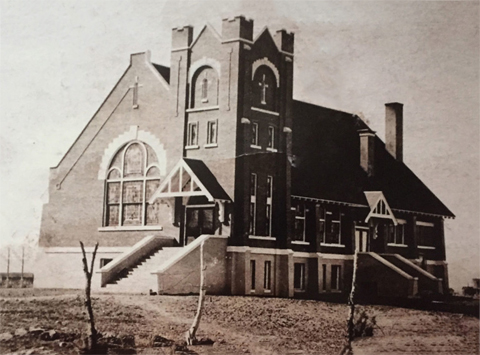(picture of Mary Edwards)
Mary Edwards, second wife of Charles Wesley Hubbard, was born May 30, 1835, at Farm Conant, Parish of Llanwenog, Cardinshire, South Wales, the only daughter and second child of John and Ann Jones Edwards.
She and her brother John, joined the L.D.S. Church and accompanied by their parents they sailed from Liverpool, England, April 17, 1855, on the ship “Chimbarazo.” After a six weeks’ passage they arrived at Philadelphia via the Delaware River. From there they went to Mormon Grove in Kansas where they outfitted and headed toward Utah with three yoke of oxen driven by her brother. Their mother died on the trip and was buried in an unmarked grave near Atchinson, Kansas. She never joined the Church though Mr. Edwards did before he died some years later in Utah.
They arrived in Salt Lake City, October 1855, then settled in Willard, Box Elder County, Utah where some of their Welsh friends lived. Their trip from Wales to Willard covered a period of seven months. The expense and difficulty of the trip left them destitute. Therefore they gratefully accepted the offer of an old Welsh friend, a shoemaker, to share a one-room log cabin with dirt floor and roof.
The father and brother were soon stricken with typhoid fever, but Mary nursed them with God’s help and they recovered even though food and medicine were scarce. They were kept warm by sagebrush which Mary gathered-the only fuel available and burned in the large open fireplace. The shoemaker’s tapping all day long on the villagers’ shoes mingled with Mary’s prayers during the cold winter months. But the Edwards family was grateful for a friendly roof in a new land.
Mary had difficulty with the English language but was an able worker and earned food for her brother and father during their long months of illness by washing and housecleaning for more prosperous settlers for which she was paid in flour, potatoes, or other items of food.
Like other converts who had immigrated to Zion, she was faithful in her church duties. Her devotion to her church and to her sick father and brother together with her calm, sweet spirit as she did her household chores for her own and others brought her to the attention of the Ward Bishop, Charles W. Hubbard.
Though she was twenty and a very attractive young woman, she had declined all offers of marriage both in Wales and America. However, when Bishop Hubbard, accompanied by his first wife, the mother of eleven children, and an interpreter, asked her to become his second wife she pondered his proposal and after a time of prayer and consultation with her father and brother, she accepted his offer.
On a cold, snowy February morning they began the sixty mile trip to Salt Lake City in a covered wagon through deep snow and bitter cold where they were married in February 1856 in the Endowment House by Heber C. Kimball , who had previously advised Bishop Hubbard that he should take a second wife to share his ample home.
In 1864 Bishop Hubbard was called by Brigham Young to assist in colonizing St. Thomas, a place in Nevada commonly called “The Muddy” where a small stream emptied into the Virgin River. He accepted the call and took his young wife and three children with him where they lived for nearly four years suffering great hardships in the sandy, hot, dry country. After this time the company of settlers appealed for release and their appeal was granted by President Young. The Hubbards returned happily to Willard with two additional children, John Hyrum and Lucynthia.
On her return, Mary Edwards Hubbard exhibited an interesting facet of her personality which has been recounted by one of her daughters:
“When the family arrived in Willard, mother showed one quality of her personality, a determination to demand what she considered right and advisable. She had lived in the home of the first wife before she went to Nevada, but she decided later that it would be best to have a home for her own family. On the ride back from Nevada, she and father had talked of a home for her and her children, but father made no promise. Mother cared not how humble it might be; she cared only to have her children to herself. Upon arrival the children joyously climbed from the wagon and went to join the other members of the family. Father told mother to get out and go into the house. He and the older boys unhitched the horses to take them to the barn. Then, seeing mother still sitting in the wagon, he said, “Mary Ann ( the first wife) is expecting you.” But mother made no move. Father returned from caring for the horses and saw mother still sitting in the wagon. He again said, “Mary, get out and come into the house.” Mother made no move, but said, “Charles, we have talked of a home for me. I am now asking you to promise me that you will get me a home where my children and I can be by ourselves” There was no scolding, no storming- just quiet, calm determination. Father knew she meant what she said. He also saw her need. She got her promise.
